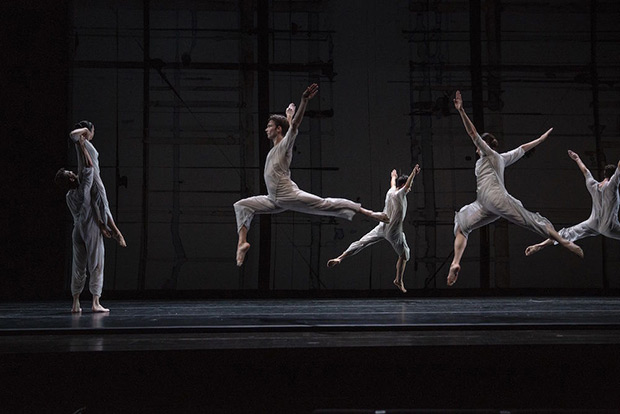
© Maria Baranova. (Click image for larger version)
Pam Tanowitz Dance with Kaija Saariaho & Brice Marden
T.S. Eliot’s Four Quartets
★★★✰✰
London, Barbican Theatre
22 May 2019
pamtanowitzdance.org
www.barbican.org.uk
T.S. Eliot’s collection of poems, Four Quartets, is considered by many, to be his finest work. A cycle of poems based on a theme of time and timelessness, the universe and a religious blend that crosses the mystical, East and West with Anglo-Catholicism, it took him six years to complete, from 1936 to 1942 and first published in 1943. Eliot also had a great affinity for dance, taking inspiration from Isadora Duncan and Vaslav Nijinsky, so perhaps it is not a surprise that the New York based choreographer, Pam Tanowitz, was drawn to creating a piece that expressed Eliot’s poetry in physical form.
Commissioned by Gideon Lester, Artistic Director of the Fisher Center at Bard College, Tanowitz began the process in 2015 after she and Lester discovered a mutual admiration for Eliot’s Quartets.
Her creation was premiered in New York in July 2018 to great acclaim. Tanowitz is ideally placed to translate poetry into dance. Her vocabulary is effortlessly fluid with clear Cunningham/Graham/Brown influences and yet her own voice is strongly established. Widely known across the pond, her work is not so familiar in the UK. What better way to introduce her than with something that takes us on an altogether different journey.

© Maria Baranova. (Click image for larger version)
Eliot’s poems are split into four sections, as the title suggests, each evoking a place of significance to the poet: Burnt Norton; East Coker; The Dry Salvages and Little Gidding. All but The Dry Salvages (off the coast of Massachusetts) are places in the UK. Tanowitz has collaborated with Finnish composer Kaija Saariaho and American painter Brice Marden to shape Eliot’s words into an inclusive, audio visual experience. Add the wonderful actress, Kathleen Chalfant, who narrates the one-and-a-half-hour piece with extraordinary, subtle resonance and a team of dancers who absolutely understand what is demanded of them and one can see that the evolution of the piece will be rapid, rewarding and constant.
The profundity of the spoken word and the response from the dancers is impactful in multiple ways. The poetry suggests movement and stillness in equal measure. First, ‘In my beginning, is my end’ or later, ‘In my end, is my beginning’ – everything is irrevocably linked, moving forward, captured in time or lingering in space.
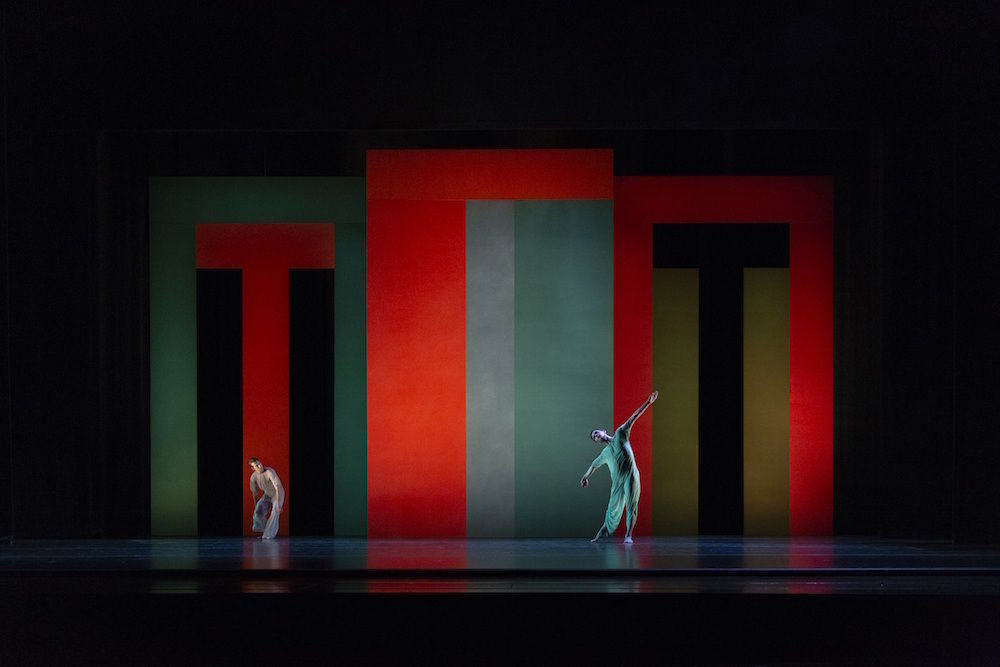
© Maria Baranova. (Click image for larger version)
Eliot’s words melt mellifluously off the tongue and inveigle their way into our minds so that they completely dominate proceedings. Tanowitz has not tried to portray the words as such, but emulates the essence of the meaning. Entirely abstract, it’s as if the dancers, instead of using sign language to translate, use their bodies to express mood. It takes a moment to get used to it, but it fairly sweeps you along as the piece gains momentum.
Near the start, Eliot writes, ‘Only through time, is time conquered.’ There are references to the natural elements in each poem, an echoing of seasonal passings. The words are so affecting, it is sometimes difficult to reconcile with the dance on stage, yet there are many passages of simplicity, with a pure classical base, stripped down to its core, that are hypnotic. Dressed in diaphanous pyjama suits (designed by Reid Bartelme and Harriet Jung) the dancers float, skit, leap and hover like dragonflies, over uncharted waters.
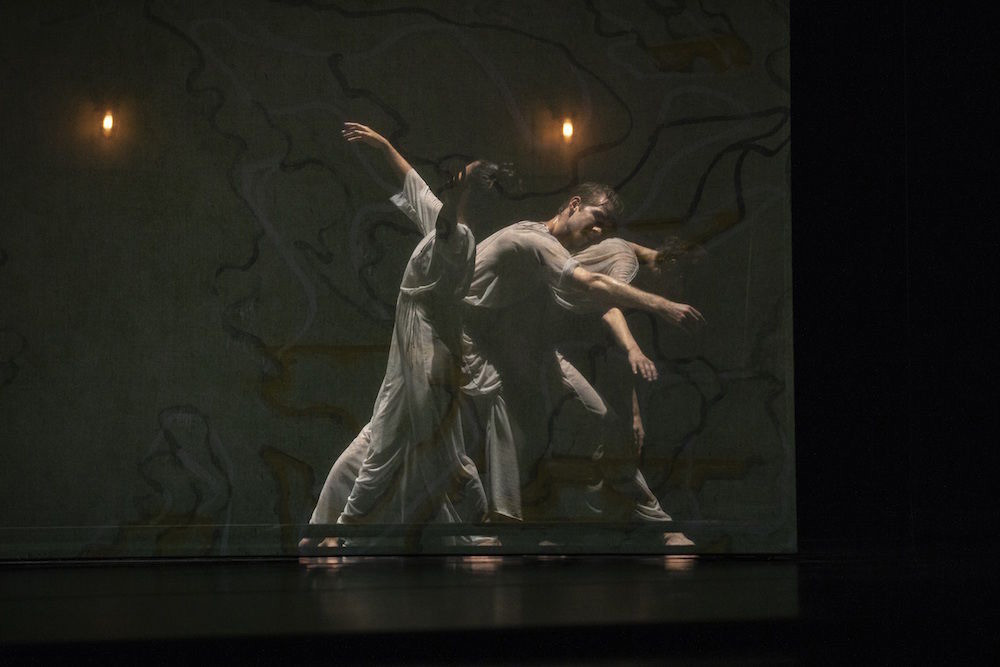
© Maria Baranova. (Click image for larger version)
Clifton Taylor has lit and designed the stage with Marden’s images to great effect. The mood shifts imperceptibly. Saariaho’s score is less engaging. Little droplets of delicate whisperings evaporate from the pit (violin, viola, cello and harp). If the intention was to enhance the narrator, it worked well enough, but as a piece of music, it lost me.
Victor Lozano in his endless solos, is featherlight on his feet and suspends himself in flight with the utmost grace. At the close, a sombre duet that sees the man sink into the splits, holding his partner’s hand is intensely moving. There is a moment of nothingness, they sit still, directly in front of Chalfant’s face. It’s a knee trembling moment – the audience captivated. It’s worth going just to hear Chalfant’s magnificent reading of the poems in their entirety. However, the rest embellishes them without being intrusive or detracting from Eliot’s genius.







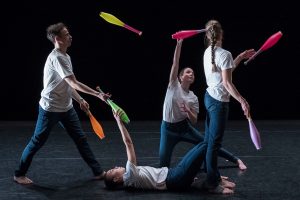

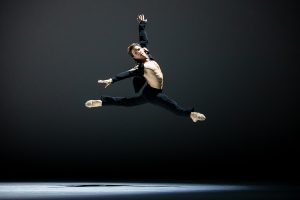
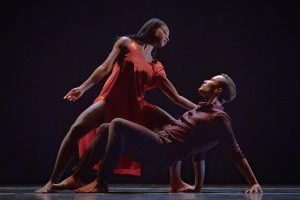





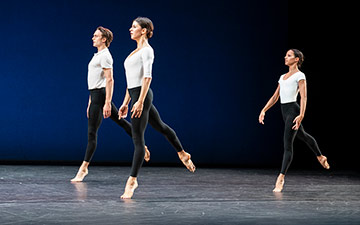
I found this review to be nuanced, insightful and gracious about the production. Therefore I was surprised that it was rated just three stars. Not that I always feel such marks equate with the value of a work of art, but for me and many of those attending a performance tonight in London’s Barbican, gave the performers a standing ovation, many having felt the interconnectedness between the visual and the verbal; the sounds and silences of the musicians; the gestures, movements and stillness of the dancers, and the wonderful narration by Chalfant of TS Eliot’s words, exuded an incredible energy, one that moved this particular member of the audience immensely.